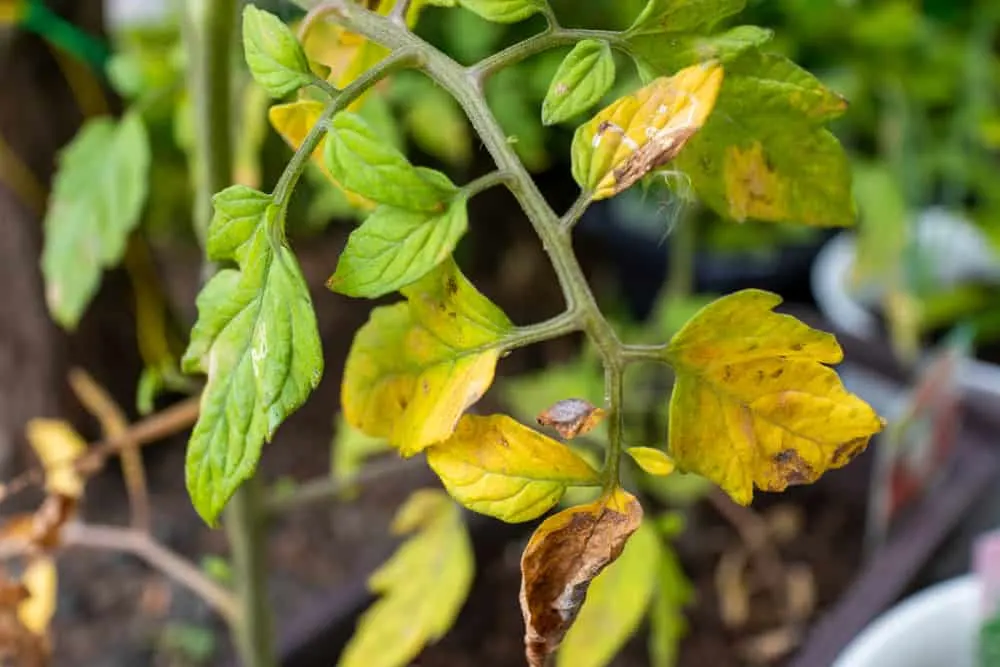
Yellowing leaves tend to induce panic in tomato gardeners.
A plant previously in good health turning from green to yellow causes alarm and results in frantic fixes that may do more harm than good.
However, yellow leaves on tomato plants are an incredibly common problem that countless tomato gardeners come across at some time over the growing period.
Most often, the problem is an easy fix (like incorrect watering), or may not even be cause for alarm at all.
These seven issues are the most common reasons for tomato leaves turning yellow. Identify the problem (if there is one at all), apply the fix, and your plants will be back to normal in no time.
1. The Seed Leaves Are Turning Yellow
Okay, let’s just cover this one first as it’s one of the most common worries for new tomato growers and shouldn’t be a worry at all.
If the leaves below are turning yellow on your young tomato plants or seedlings, do not worry.
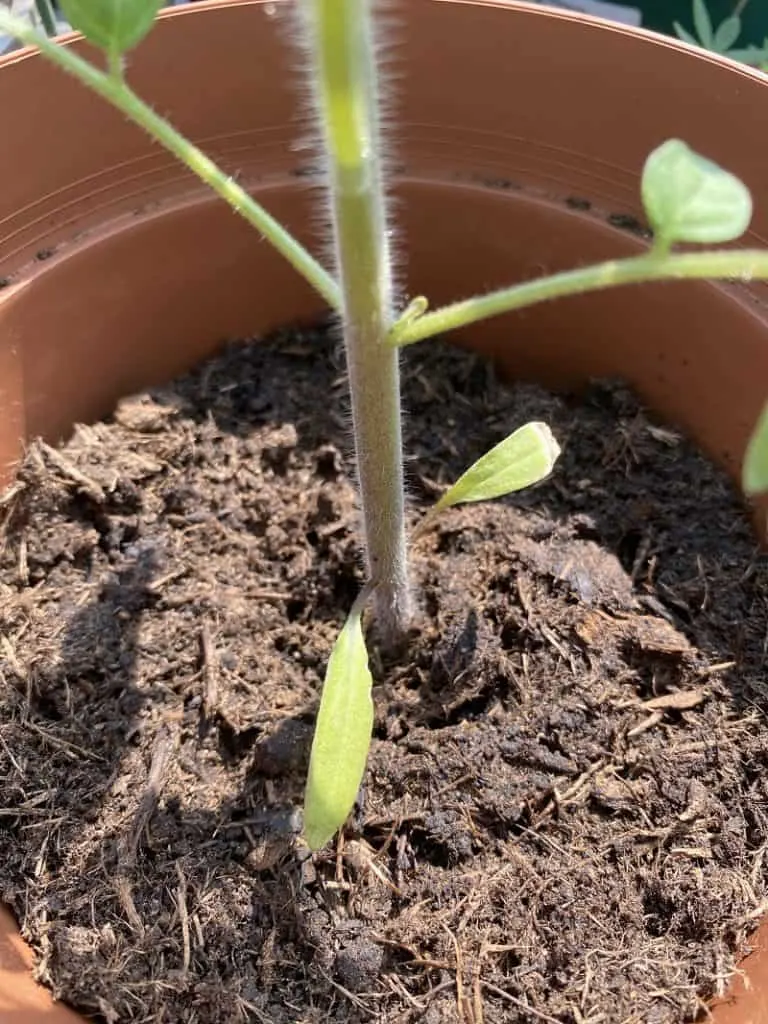
These are the seed leaves (also called cotyledons). They are the first leaves to form when the seeds germinate but are not “true” leaves.
It is part of the development process that these leaves turn yellow and fall off and is absolutely noting to worry about.
2. Watering Problems

The Cause
The most probable cause of yellowing leaves on tomato plants is incorrect watering. Watering is a practice many gardeners get wrong – sometimes by providing the plant with too little water, but often by providing too much.
Take a look at our total guide to watering tomato plants here.
In our efforts to keep the plants happy, gardeners may overdo it on the care front and give the plant far more water than it really needs in fear that the soil will dry out. The excess water in the soil can suffocate the roots and cause them to rot. As the roots are damaged and there is less oxygen in the soil, there is less oxygen available to the leaves, causing them to turn yellow and drop off.
Underwatering can also cause the leaves to turn yellow after wilting. If underwatering is the problem, the leaves will begin to yellow from the edges, until the entire leaf drops off the plant.
The Fix
You will likely know if watering is the culprit by assessing your watering habits. If you have watered when the top layer of soil is still wet, or if the soil has become waterlogged, overwatering is likely the cause. If the leaves are wilting and the plant is struggling to stand upright (or if you know you’ve forgotten a watering session or two), underwatering is your culprit.
Correct watering is essential to the health of your tomato plants. Check the soil every day and only water when the plant absolutely needs it – approximately when the top 1 or 2 inches of soil has dried out.
Water in the mornings to prevent any evaporation or damage to the leaves. Apply water to the soil around the roots, not to the leaves, and water slowly and deeply to completely saturate the soil and encourage deep root growth.
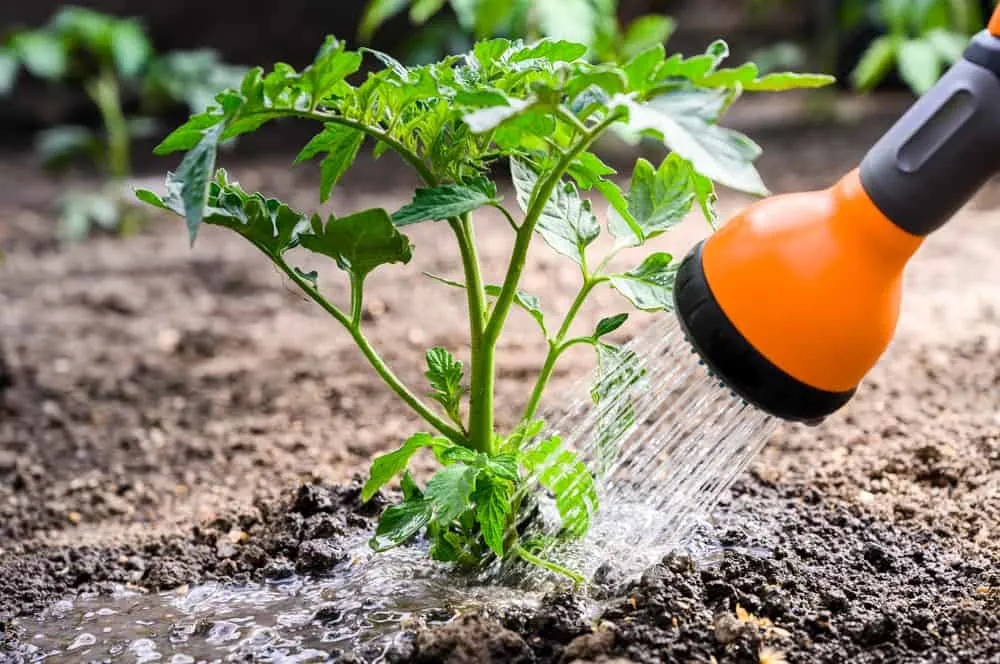
If overwatering is the cause and the problem does not fix itself, you may be dealing with a bad case of root rot.
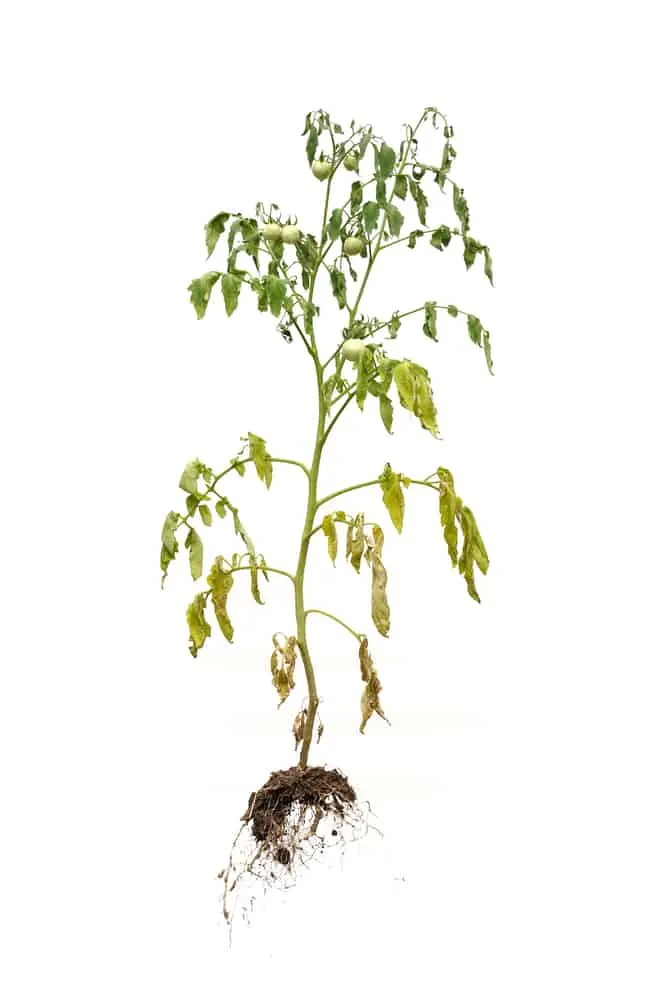
Unfortunately, it is very difficult to save plants at this stage. You can dig up the plant, remove the decayed sections of roots, and plant in brand new soil. However, depending on how much of the root is left, and the growth of the plant, it may be best to start from scratch.
3. Soil Compaction
The Cause
A similar problem occurs when the soil around your tomato plants has inadequate aeration. The roots do not have access to enough oxygen and begin to suffocate. The roots cannot transport the oxygen, water, and other nutrients throughout the plant. This causes the leaves to turn yellow and is a sign that the plant is on its way out.
The Fix
Depending on how established the roots are, you can aerate the soil yourself by loosening it with your hands. However, this is likely to damage the root system and can cause more issues. It is best to start the plant in good soil enriched with organic matter to avoid this problem altogether.
Soil compaction is often caused by walking on the soil, so growing tomatoes in raised beds or large pots is one way to solve the issue.
4. Transplant Shock

The Cause
If you’ve recently transplanted your seedlings (around a week or two before) and notice yellowing leaves on the bottom of the plant, transplant shock is likely the cause.
When seedlings are moved from a warm spot – indoors or a greenhouse – to cold soil outdoors, they need time to adjust to their new conditions.
The shock can cause the bottom few leaves of the plant to turn yellow. Luckily, this is just a short phase of adjustment. As long as the new growth is green and healthy, there is no cause for alarm. The yellow leaves will eventually drop off and the plant will return to good health.
The Fix
As transplant shock is not usually detrimental to the plant, and not necessarily fixable once it is discovered, it’s best to prevent the problem instead. Before transplanting, ensure the soil has warmed and that night temperatures don’t drop too low (below 50F).
If you discover signs of transplant shock, you can aid the plant’s recovery by removing the yellowing leaves at the stem. This will direct the energy toward the much-needed new growth and away from trying to keep dying leaves going.
5. Diseases
The Cause
One of the more insidious causes of yellowing leaves is disease. Several tomato plant diseases cause yellow leaves, and many of them are difficult to tackle once established.
The first culprit is early blight, caused by a fungus in the soil. Luckily, this problem is easy to spot. In the lower leaves, a pale-yellow spot will appear, turning into a dark brown patch with yellow at the edges. If left untreated, the entire leaf will turn yellow and drop off.
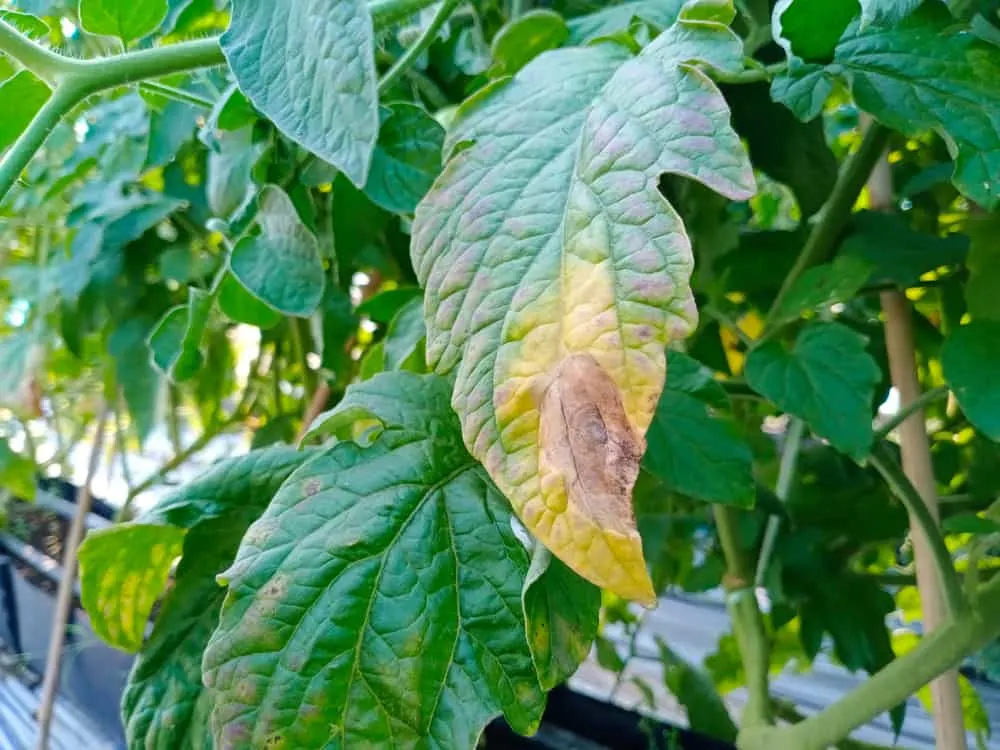
Similar markings appear due to another fungal disease, Septoria leaf spot. Tomato plants affected by this fungus will display large brown spots in their leaves, connected by patches of yellow. Untreated, the problem can move from the leaves to the stem of the plant and cause even more damage.

Then there are the various ‘wilts’ – Fusarium wilt, Verticillium wilt, and Bacterial wilt.
Fusarium wilt begins in the soil and infects the plant’s roots, preventing the transportation of water to the stems and leaves of the plant. The plant will appear wilted, even though there is enough water in the soil, and the leaves will begin to drop off the plant from the bottom up.
Signs of Verticillium wilt are similar to early blight and Septoria leaf spot. On the lower leaves, pale yellow spots begin to develop, surrounded by brown veins. These spots will eventually turn brown and the leaves will fall off the plant.
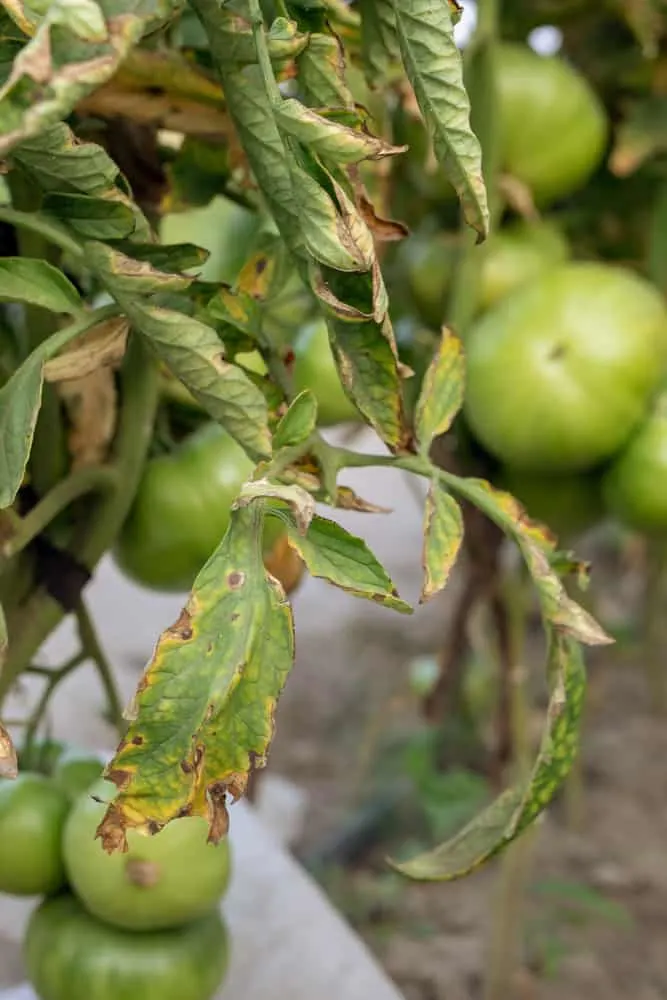
Less common is Bacterial wilt, caused by a bacterium commonly found in sandy soils when they are moist. This disease typically begins upon transplanting but doesn’t develop signs until later into the season. The leaves turn yellow suddenly and the plant will start to wilt.
The Fix
Any signs of disease in your tomato plants require immediate action. If left untreated, the problem can spread to the rest of your plant, and to other parts of your garden.
Early blight and Septoria leaf spot can be managed if discovered early. Remove the affected leaves and discard them, keeping them away from other plants in your garden. Apply a fungicide designed to treat the issue, following the instructions on the product exactly until the problem improves.
Unfortunately, if you encounter any of the three ‘wilts’, you will have to discard the plant immediately. There is no cure for any of these diseases, and they will spread around your garden if they get the opportunity. When removing the affected plant, ensure it does not come into contact with any other plants to avoid spread.
While there is no guaranteed way to prevent problems with diseases, there are measures you can take to limit your risk. Choose varieties with greater resistance to these diseases and give each plant enough space so the leaves do not touch. Clean your gardening tools regularly and practice crop rotation for good soil health.
6. Nutrient Deficiency

The Cause
If none of the previous problems explain your yellowing leaves, you may be dealing with a nutrient deficiency. This could either be the result of a lack of a certain macro or micronutrient in the soil, or a problem with the plant’s ability to absorb that nutrient.
The main macronutrient culprit of yellowing leaves is nitrogen.
Nitrogen is essential for a plant’s healthy growth and leaf production. When the plant does not receive enough nitrogen, the older leaves will begin to turn a pale yellow. If you notice the plant stops growing after this period, lack of nitrogen is your answer.
A lack of certain micronutrients can also cause the leaves to yellow as a result of a condition called chlorosis. When the tomato plant lacks access to micronutrients essential to photosynthesis – magnesium, iron, sulfur, or zinc – it cannot produce chlorophyll. This causes the leaves to turn yellow, while the veins remain bright green.

The Fix
If you suspect nutrient deficiency is the problem, apply a general fertilizer. Most all-purpose fertilizers will have a balance of nutrients to offset any deficiency in the soil.
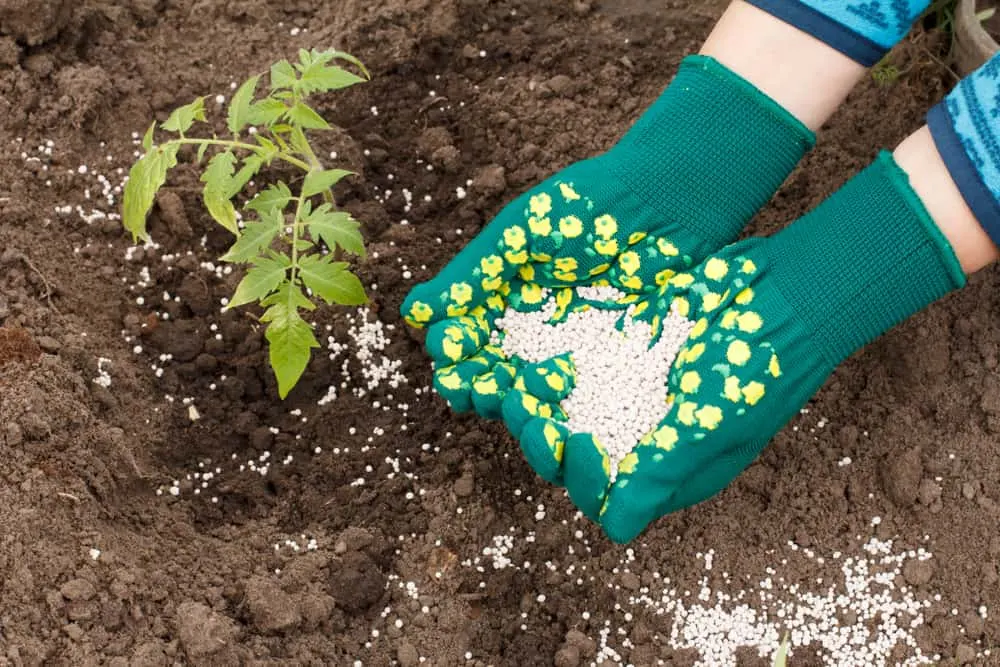
To be certain, it is best to conduct a soil test. This will confirm the origin of the problem and allow you to fix it with a targeted solution.
For example, magnesium deficiency can be combatted by the application of an Epsom salt mixture on the leaves. Without a soil test, you cannot be certain of a deficiency and may end up damaging the plant further by applying fixes that are not necessary.
A soil test will also confirm whether the soil is the problem, or whether the plant is the problem. Remember, nutrient deficiency in a plant is not always caused by a problem with the soil. There may be an issue with the roots of the plant that cannot transport nutrients throughout the plant, rather than a problem with the soil specifically.
If the soil test confirms no deficiency in the soil, examine your watering habits and the aeration in the soil to fix the problem.
7. It’s The End of the Season
Before running through any of these scenarios and applying a million fixes, examine the time of year.
Is the tomato season ending? If so, yellowing leaves are no cause for alarm. Rather, they are a part of the plant’s natural lifecycle, signaling production is coming to an end.
Once the leaves start to drop off, you can trim any new growth and dying leaves to encouraging the ripening of the final fruits on the plant.

The first rule of any gardening fix is – don’t panic.
Based on the signs mentioned here, your analysis of the plant, and your care routine, you will probably know which problem is the most likely one.
When attempting to fix problems with yellowing leaves, always take it slow to allow the plant time to adjust before you move on to another fix. That is, unless the problem is disease-related, in which case you’ll need to act immediately (but luckily diseases are generally easier to identify).
It is a game of trial and error. If one fix doesn’t work, gradually move onto another until the plant returns to normal. In no time, you’ll have the diagnosis skills of a successful plant doctor and will be able to fix tomato plant problems with ease.
